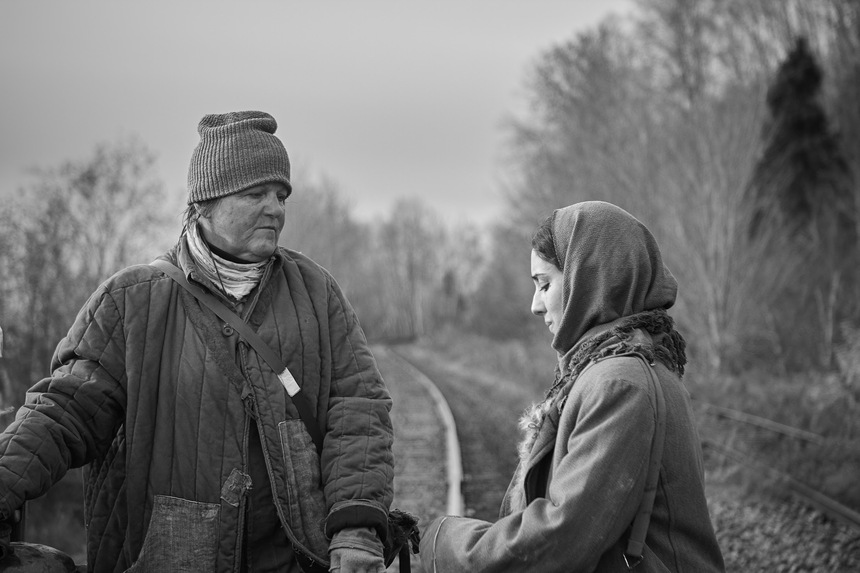Slamdance 2021 Review: NO TRACE, The Bleak Yet Hopeful Edge of Existence

We tend to have certain images that come to mind when we think of a near-future where our civilization has been irrevocably altered: lack of electricity, roaving bands of mercenaries or rebels, women especially both prized as possessions and in danger, smugglers and black markets, and an overwhelming sense that life is lived moment by moment, without much hope of change or improvement. Add in a place already far removed from what we would call 'civilization', sparsely populated, mostly untouched, yet still with those who must fight for existence, and the world can seem bleak and cruel.
For the opening night film of Slamdance, Simon Lavoie's No Trace is something of an atypical choice: an intimate and experimental narrative, it's set up like a jigsaw puzzle of which crucial pieces have been lost to time and some unknown distaster. With few characters and perhaps a few dozen lines spoken in its 100 minute running time, its sparseness is matched in form and sound, and yet its meaning lays in these pieces like breadcrumbs across the barren and beautiful landscape.
In some future (perhaps nearer than we think), N (Monique Gosselin) is some kind of smuggler; she rides her handcar, outfitted and equiped to serve her needs and those of her 'customers', crossing the border of the 'Territories' delivering whatever will keep her fed and warm. She's been hired to deliver Awa (Nathalie Doummar), a young Muslim woman, and her baby across this border so they can reach her husband and safety. But as with most things in a post-civilization world, nothing goes quite to plan, and N and Awa find themselves dependent on each other after a devastating event.
Filmed on and around a lonely stretch of railroad on the north banks of the St Lawrence, this is a part of Québec that few see, a place where you could keep walking one way and hit the river, but the other way and you're walking as far north as possible. This is a place with both a natural stark beauty, as well as a loneliness that clings to the river's edge as the only means of both transportation and hope. N's existence might be day-to-day, but she knows it and is left to do her work: transporting goods left and found under small bridged, finding information in code, thankfully left mainly in peace by those who now control this territory (as long as she bribes them well enough). This same courtesy is not afforded to Awa, a woman whose youth and religion make her a prime target (hense her dangerous journey).
Lavoie and his cinematographer Simran Dewan used two interesting techniques for the visual language of the film, in filter and scope. The first makes the film not just black and white, but gives a brightness that suggests what might have happened in this world, as well as a sense of the disreality of existence. The occasional change of ratio from rectangular to almost square, back and forth, shifts our focus: at times the landscape is on display for us to both watch in awe and fear; at others, we are solely at the mercy of the character's face and view, their world now narrowed to barely more than basic survival.
It is the main question that hangs over the film: why try and survive? N seems to exist because, what else is there to do? She at least has some semblance of safety, she has a profession, so to speak, and is in at least some small control of her destiny, and at least until she encountered Awa, was perhaps unaware of the depth of loneliness in her existence. Awa has her faith: it is the fire that keeps her warm, though later, it might be the rock weighing her down. The women keep proverbially circling each other, and this question of existence, through their life experiences and whatever power or energy they find in the universe.
As with another recent Québecois film that examined a post-civilization world, Les Affamés, the situation of the rural population, already at the edge even before things went to hell, it suggests a crack in the seams of reality. Their losses bring out different behaviour: N, usued to being alone, finds herself unwilling to leave Awa. Awa, now utterly alone, refused to accept what has befallen her and descends into a quiet madness. N suddenly tries to find, and thinks she sees clues, of meaning, as bleak as it might be; Awa finds her faith the only solace she has left.
This circular descent at times perhaps stretches a bit thin; there's only so much that can be done with two characters in a single location, with little dialogue, the point being made, without moving forward. Though that is arguably a reflection of their existence. Gosselin and Doummar are both excellent, two people whose disparate identities and experiences lead to different extremes in behaviour and reaction, which cannot necessarily be compatible, even if they need each other to survive.
Working in that space at the edge of civilization, and by extension the edge of the known, No Trace narrows in on two specks of humans in a world too vast and too inhospitable to them, and tries to find them hope. By stripping away artiface and taking a surrealist route and view, Lavoie ponders what lies beyond what we think we know, about an uncertain and obscure future.







